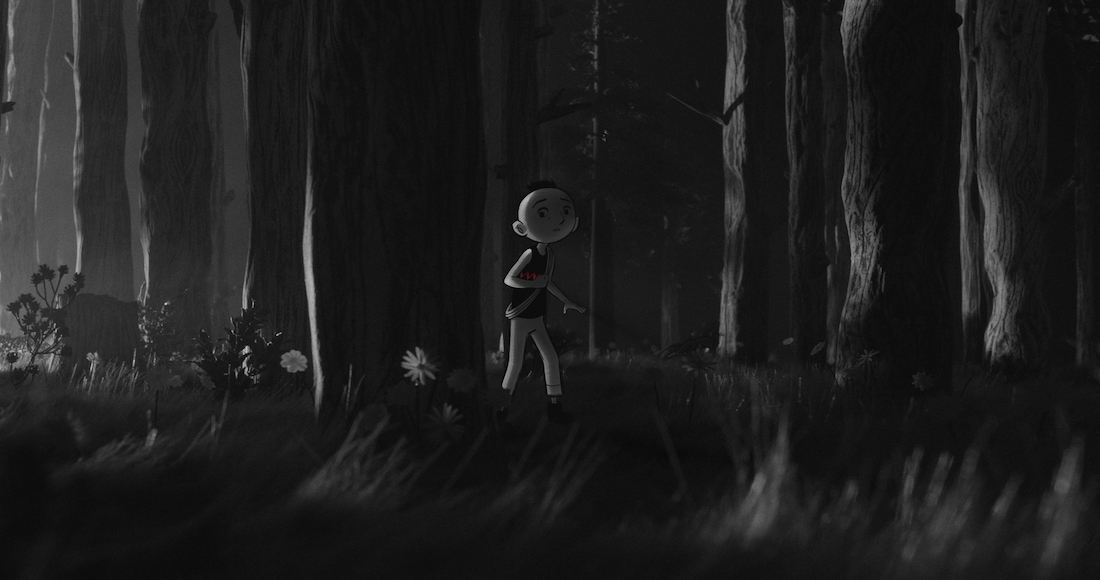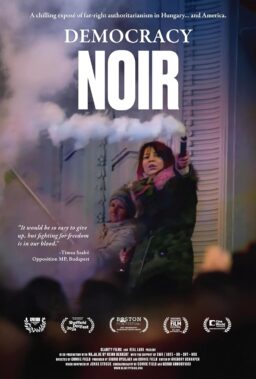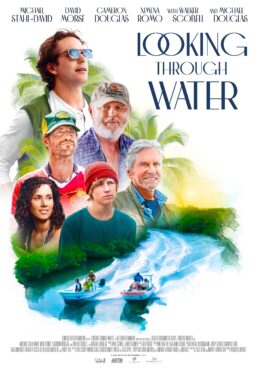Sergei Prokofiev’s orchestral classic Peter and the Wolf has been adapted countless times either as a recording, performance, or animated film. Can anything new be brought to the story or the music? U2’s Bono and frequent collaborators Gavin Friday and Maurice Seezer put together their own recorded version and illustrated companion book in 2003 as a fundraiser for the Irish Hospice Foundation. Twenty years later, it has been adapted into a short animated film (premiering on MAX on October 19th), retaining the original recording as well as Bono’s illustrations (which he did with his daughters, Jordan and Eve Hewson) as a starting point of what evolved into a breathtaking visual palette that sticks to just a few primary colors and comes loaded with a variety of visual textures.
“Peter and the Wolf” is nothing without Prokofiev’s composition, which, even today, remains a go-to source of lesson planning for music classes as a way of teaching about distinguishing instruments and their purpose. Every character in “Peter and the Wolf” famously has their own instrument and theme to represent their character. In this musical version, Friday and Seezer put their modern musical spin on it without diverging too far from the original, favoring heavy percussion, banjos, and Seezer’s trademark accordion. The themes cleverly travel with the characters. When the Duck goes underwater, so does the music.
Stephen McNally and Elliot Dear’s beautifully directed film follows the story fairly traditionally. But there have been many different takes on this piece over the decades that the question of faithfulness to the source material never really matters. This one has a clever twist at the end that differs from any recorded version I heard as a kid, as well as the popular Disney version and Suzie Templeton’s Academy Award-winning 2006 animated film (the two film versions I’m most familiar with). Its twist on the Wolf being an illusion and the gullible nature of those who go through life with a peculiar bloodlust makes the story worth telling again.
Many grew up with a storybook version of Peter and the Wolf with the music and accompanying kid-friendly narration. As he did on the original CD recording, Friday lends his unmistakable, velvety baritone voice to the narration, which takes the animated form of a fly who occasionally appears in the corner of the screen. Friday has just the right amount of whimsy, which is to say, not too much. His delivery might take some getting used to for anyone looking for a half-hour time killer for their kids, particularly since the cat character is simply named Pussy, and Friday loves that word. This “Peter and the Wolf” has a refreshingly wicked side to it.

The character of Peter has been changed from the traditional farm boy to a child punk rocker who is linked to the Wolf via a simple zigzag illustration that appears on the boy’s shirt and the design for the Wolf’s teeth. Bono himself is seen illustrating the Wolf at the start of the film. U2 fans will note that the character of the Grandfather looks a lot like Bob Hewson, Bono’s father, which makes the dynamic between Peter and his Grandfather all the more interesting, with emotional walls between them. The first time we see them, they have returned from a funeral for the boy’s mother. One of the film’s final messages (“Are those who we’ve lost ever really gone?”) makes this one of the most personal interpretations of “Peter and the Wolf” that has ever been adapted.
This is not to say the film has no humor or warmth. McNally and Dear have the Bird and the Duck provide the comic relief, and they have been rendered quite charmingly. Anyone with a duck-quack ringtone on their iPhone will constantly be checking for a phone call anytime the Duck opens its mouth. There is also some fun in the closing credits over the optimistic song “There’s Nothing To Be Afraid Of.”
I imagine some traditionalists will have their preferred version of “Peter and the Wolf,” whether it be a short film, cartoon, or orchestral recording, and they might have some reservations about this version. Still, one cannot deny the richly textured animation on display here. McNally and Dear’s team have created a wondrous setting, seamlessly blending elements of 2-D and 3-D animation (I’m hoping for an accompanying making-of documentary at some point), giving the 2-D characters a tangible landscape in which to exist. The sorrowful blackness of the house’s interior gorgeously contrasts with the bright white grasses and trees outside until the two shades blend in the story’s latter half. The reds are used playfully, not with enough consistency to detect any thematic throughlines in the overall piece, but it looks lovely all the same.
“Peter and the Wolf” is clearly a labor of love for all involved, and the fact that it has been made with the Irish Hospice Foundation as its impetus makes it all the more rewarding. This new version of Prokofiev’s timeless classic is one of the best and most original interpretations, and it gets better with repeat viewings.

Interview with narrator, composer, and executive producer Gavin Friday
Let’s go back 20 years. Why Peter and the Wolf? Creatively speaking, what was the interest there for you, Seezer, and Bono?
Twenty years ago, it was in the subconscious. You knew it as a kid. But 23 years ago, I started to do some charity work for the Irish Hospice Foundation and had an innovative idea to say, “Let’s not do ordinary charity things; let’s do some charity things that have more bespoke or artistic content.” So, we put out a book called Who’s They? Then we brought out a deck of cards where we had 52 artists design each card, I being the joker and the second joker being Bono. And the question came up, what should we do for 2003? And I had just re-listened to an old Peter and the Wolf recording by Sean Connery, and it just brought back loads of memories. So, I said, “Why don’t we do a new version of that?”
At the same time, Bono’s dad had just passed and had great palliative care with the Irish Hospice Foundation. It just made sense when we recorded it. He said, “Well, I’ll just do the drawings.” So, it was very spontaneous. The Irish Hospice Role is always at the center of it.

And they’re involved with this new film as well.
Yes. The recording back then, we did quite a different version. I went through all different kinds of versions; Connery’s version happens to be my favorite. I remember the first recording I bought was [David] Bowie did it in 1978
I didn’t know that.
Yeah. It’s not very good, sadly. [laughs] But Sean Connery’s is the one I go for. Danny Kaye did a great one. I have a fetish for collecting any version I come by, especially on vinyl. But I decided then, “Look, it’s a children’s story; it’s for a book. Let’s make it contemporary.” And even before the idea of animation, when I was thinking of the music and the new arrangement of the music, I thought, “What would Tim Burton do?” If he would make it a contemporary, scary fairy tale. We sort of left out the orchestra. Because kids don’t really care if it’s interesting music or not very interesting music. And we brought our own interpretations through accordions and banjos and made it much more eerie and scary. And even the percussionists were by Tom Waite’s percussion player on those wonderful albums like “Swordfish Trombones.” So, the element of the theater was always there, and me, having a semi-gothic past and being in love with those old “Hansel & Gretel” fairy tales, I decided to go deep, dark, and mysterious (in a low voice) “This is the story of Peter and the Wolf.” It’s sort of how kids’ fairy tales should be in my mind. A little bit of grit, a little bit of punk about them, you know.
Yeah, it reminds me of the films from Laika studios (“Coraline,” “Paranorman,” “Kubo and the Two Strings”). You have done spoken-word performances in the past. I think on your “Shag Tobacco” tour in 1996, you did some. Was this a logical extension of that? Or did it feel different because it was someone else’s story?
It did feel a bit different, but away from just “Shag Tobacco,” which was my first venture into narrative, I also, about twelve years ago, worked with the Royal Shakespearean Company, where the classical composer Gavin Bryars, let’s just say he’s Britain’s Phillip Glass. He wrote a beautiful piece you may know called “Jesus’ Blood Never Failed Me Yet.” This guy was commissioned in 2008 to put Shakespeare sonnets to music. He chose very different narrators and singers to write an original composition based on a sonnet. I did one, and the Shakespearean Company was quite taken with my voice and asked me to do the narration for the whole show, which toured on and off for about ten years. I did two or three shows a year with them. So, I had my Shakespearean training. It was tough working with them, and it’s all very classical and to the point, but it was like going back to school. Stuff like narrative and Shakespeare was something I feared as a teenager, but then delving into the sonnets and understanding the beauty of them was like going back to school but in heaven. I really enjoyed it.
And I learned a bit from it, so it was quite natural to do that narration (for “Peter and the Wolf”) for this new narrative, which is re-recorded. It’s a new narrative for this 2023 Max release.
Yeah, so let’s dive into that. How did this animated version come about? What was the impetus for getting this thing going?
Believe it or not, Covid. [laughs] It sounds strange, but the rights of the recording that I did on the original for Bloomsbury Books had come back to me and (co-composer) Maurice Seezer. We said, “Would we re-release this?’ We went to the record company, the same guy who published it originally 20 years ago, Alistair Norbury from BMG Records, who said, “Why don’t we, as well as re-release it, re-record it and make an animated movie?” We were just about to get negotiations going when Covid came in. I’m happy to say that COVID was very interesting because over the two years of lockdown, and we had a very severe lockdown in Ireland, I worked three or four days with HBO and Blink animators and, basically, worked on the movie for those two years.

How much input into this new telling did you, Bono, and Seezer have with directors Stephen McNally and Elliot Dear? There are some changes in this one.
There are a lot of changes. Maurice Seezer used the same recording we did 20 years ago, the same music. It’s the narrative we changed. Bono embraced the idea. He was so glad that his drawings were going to be reinterpreted and animated. He says, “Good luck there, but you curate them for me and make sure you don’t mess it up.” Because we were both very taken with this almost expressionistic version of how he painted his drawing originally. All the original drawings from 20 years ago were the touchstone and the seeds for the start of the animation.
When we first got into conversations with Max, it was, “Well, 2023, you can’t really kill a wolf, can you? In 2023, you can’t really put a wolf in the zoo, can you?” And at one point, someone asked, “Gavin, what sex is the wolf?” And I was like, “Wow!” [laughs] And of course, you don’t want to kill the wolf or put it in the zoo. We started looking at it, myself and Stephen and Elliot, basically a think tank, and we got into working three hours every two days on the script and the idea and the fact we decided then that it was going to be for Hospice, it just came up simply: “Why is a 12 or 13-year-old boy living with his grandfather? Oh, maybe his mom and dad have died. Maybe he’s dealing with grief.” And suddenly, this small fairy tale that we’ve all known, let’s turn it into something really positive, almost like a poem or a way for parents to show their kids dealing with loss or grief in any way.
Yeah, and the timing of the release is interesting because Bono appears at the beginning and at the end of the film. A lot of U2 fans who follow their work very closely, especially in the last year with [Bono’s autobiographical] Stories Of Surrender project, will look at this as a parallel to his life. Peter is coming home from a funeral for his mother. His grandfather looks a lot like [Bono’s father] Bob Hewson.
That’s deliberate, yes. All the original characters were based on people he knew. And Bob was the basis of the Grandfather, yeah.
It’s a great way to repurpose it and make it more personal.
Yeah. I mean, the timing is just coincidental. This was always timed for a 20th-anniversary re-release. So, two or three years ago, I don’t think U2 knew they were doing the Sphere [shows in Las Vegas] or Bono was gonna do his one-man shows. It’s serendipity, I suppose, or an interesting coincidence.
The ending of this Peter and the Wolf differs from other versions. Was that based on another version you’d seen, or did you all completely make this one up?
No, that’s a completely new re-telling, and that was the definite answer to our conundrum of, How do we end it without killing the wolf? Don’t kill the wolf. We set the wolf free. One of the big challenges was taking Bono’s drawings, which are very abstract, blunt, and very expressive. How do you animate that wolf? So, the idea I had was the big, bad wolf is really in the imagination. And we’re sort of asking children to think outside the box. It’s that chalk drawing you see on the wolf. It’s basically the kid’s idea of fear and the unknown and the big, bad world out there, especially if a kid loses a parent or a friend. So, it’s just trying to explain that there’s nothing to be afraid of. Make fear your friend. That became like, “Let’s do an ‘Ocean’s 13.’ Let’s do a doppelganger.” And it just sort of rolled and happened very spontaneously.
Was there ever a discussion on when the color red would show up?
There was, and that was to keep it in black and white. The original drawings were in black-and-white, except for one color: the ziggy stripe on the kid’s jumper and the tongue and the teeth of the wolf, and that’s all the color it was. We love the aesthetic and that limit. The animation is quite beautiful in that it’s all hand-drawn, but we made it 3-D, so the forest and the elements, the car, they’re all built, so it’s almost like going back to the fairy tales on TV that you saw that were the old animation. I’m not a lover of digital animation, personally. I like old-school things, so we tried to reinvent it that way. I like the use of it in this way, on the wolf’s tongue and on Peter’s jumper.
The whole texture of the film is so incredible. Was there a discussion beforehand on what kind of animation to use before you and the directors settled on this?
Yeah, Blink were the animators, Stephen and Elliot. They knew I was forceful on the aesthetic, in that I did see in black-and-white, old school and almost with a bit of grit in it. And they said, “Let’s do it in black-and-white and let’s do it in 3-D, or as much 3-D as we can. I was totally engrossed in it. They’re building these sets, just extraordinary, like falling into the fantasy again. There used to be a program called “The Magic Roundabout” when you were a little kid. You get transfixed back to that. So, it was a conscious plan to go against the grain and to have that authentic thing. Visuals are like sounds. They become bland. They become all homogenized. To make something that stands out, you have a better chance of being really loved. That’s what the aim was.
The new recording of “Peter and the Wolf” is now available on hardcover. More information on the new recording can be found by clicking here. “Peter and the Wolf” is available on Max on October 19.












